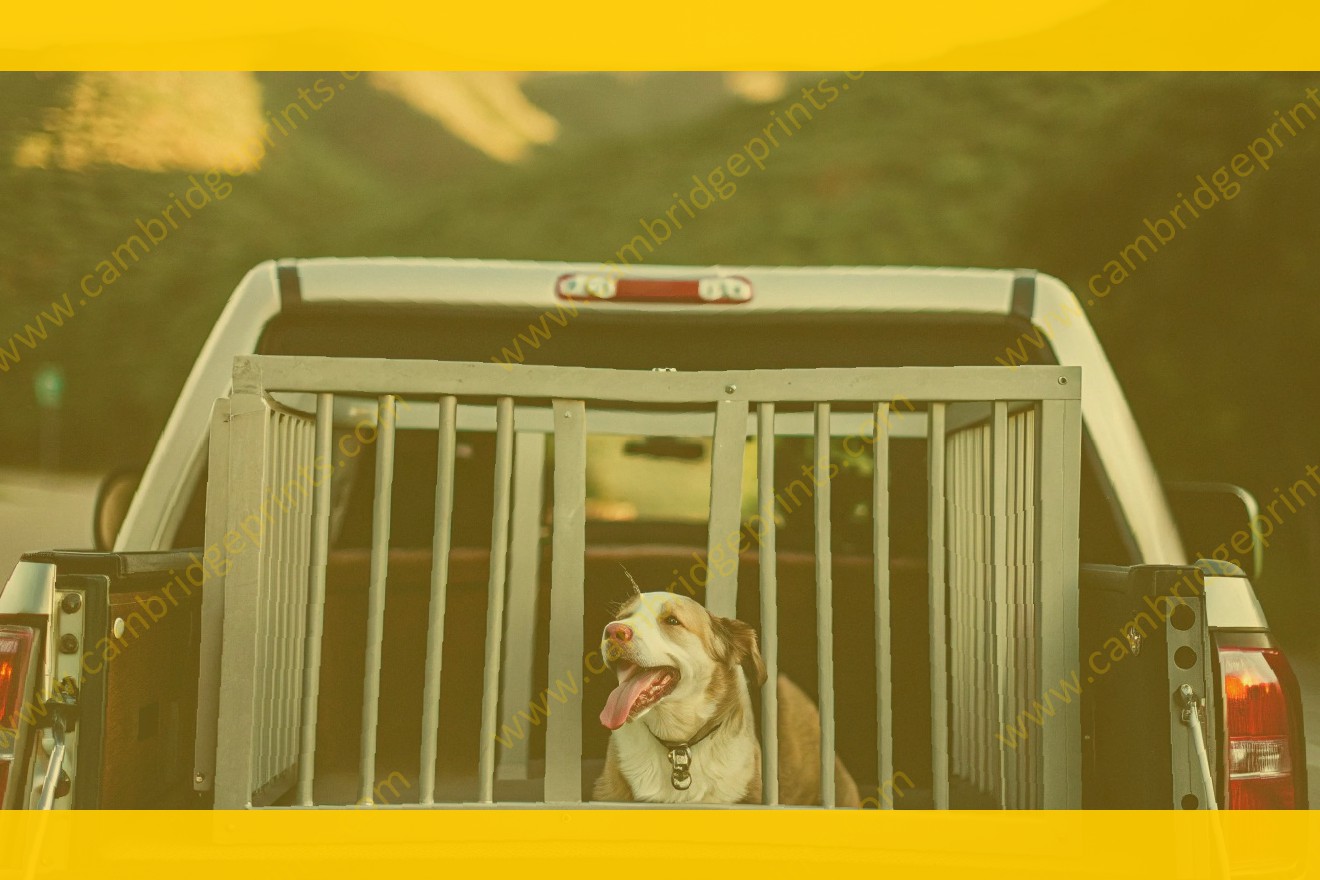California Law Regarding Dogs in Truck Beds
California has a law specifically addressing how animals are to be transported in the back of pickup trucks. Once again, Animal Legal & Historical Center is a reliable source for the text of California law on dogs in truck beds, as well as other animal laws. In this excerpt taken from their site , the California law addressing how dogs must be transported in the back of trucks is explained: "A 2010 amendment to the California Vehicle Code prohibits a person from driving with an animal upon the open bed of a pickup truck unless the animal is contained in a cage, in a restraining harness, or in a pet travel cage."
Safety Regulations and Exemptions
Exceptions to the Rule on Dogs Riding in Truck Beds in California
When it comes to dogs riding in the back of trucks in California, the Uniform Vehicle Code (UVC) offers a very broad definition of what a truck means—inclusive of the tailgate of a pickup truck and a dog crate attached to a full-sized pickup truck. The technical definition would mean any motor vehicle that is specifically designed for, or adapts its body to transport cargo and not consisting exclusively of a passenger compartment.
However, the UVC also provides exemptions in which a driver may still be subject to punishment if they do not properly and safely secure their animal. California law recognizes the general rule for transporting dogs and other pets in the back of trucks, but also makes exceptions to the rule. For example, a driver is not breaking the law if they unsuccessfully attempt to restrain their dog before it jumps out of their vehicle or extenuating circumstances prevented the restraint.
If a driver cannot see their dog, they are unable to fulfill their responsibility to secure the animal. In this case, a driver should try to pull over as quickly as possible and tend to the needs of their pet before proceeding on. In a few limited situations, however, a driver may legally transport a loose animal in a truck.
Where the law specifically exempts a driver from punishment and recognizes that it is not possible or practical to restrain a dog, the law is reasonable. For example, if a driver is forced to swerve in order to avoid an animal running across the road or if an emergency requires sudden evasive action—such as requiring the driver to swerve to avoid killing a deer or to assist another driver in distress—then the dog may jump from the vehicle before the driver can react. In such a situation, stating that the dog must be restrained in such an emergency would be unreasonable.
Violations and Penalties
Although the law requiring dogs to be in positioned restraints while being driven in a truck bed goes into effect on January 1, 2022, failure to do so is already punishable under California Vehicle Code § 23117(b), which states that No person may drive a motor vehicle on a highway while holding in his or her arm … a dog … or another animal. A violation can lead to a fine of $35. This is also true under California Vehicle Code § 22371(a) which states that No person or persons shall allow any dog … to ride on the outside or open part of, in or on, a motor vehicle or trailer except as provided in Section 23222 or 23223.5. A healthy minimum six-month jail sentence and a $1,000 fine is the penalty for a violation. Furthermore (and significantly), if as a result of a violation a dog is bitten by a vehicle or falls out of the vehicle injuring itself or someone else or it jumps out of the vehicle while being chased by another vehicle resulting in injury, death or property damage, the driver can face stiff criminal penalties. For example, a violation of California Penal Code § 597(b) which makes it a misdemeanor by when any person who directly, or through another person, intentionally does any of the following is subject to imprisonment in a county jail not to exceed six months or by a fine not to exceed twenty thousand dollars ($20,000), or by both that fine and imprisonment: (e) Causes or procures any animal to be placed in or on any vehicle with the intent to leave the animal there and keeps the animal there for any period of time, knowing that the animal is unreasonably exposed to the elements.
The Importance of Animal Safety
Transporting dogs in the back of a truck poses obvious safety risks, as evidenced by the lobby campaign for animal safety laws undertaken by actor LASSIE in the early 90s. In a public service announcement broadcast on television sets nationwide, this lovable fictional collie reminded viewers of the dangers of putting dogs in unsecured areas of a vehicle , with footage of a dog being thrown from a vehicle traveling sixty miles per hour. As any person who claims to love their pet will tell you, his dutiful dog is his best friend. For California vehicle safety laws, that means no riding in the bed of pickups. Whether your passenger is human or a Rover, your number one responsibility is to keep them safe.
Safe Alternatives
As we have seen in the previous section "California Law on Dogs in Truck Beds", transporting a dog in the bed of a truck is not safe for the dog or the operator of the vehicle. Fortunately, there are a number of alternatives for transporting a dog in a vehicle, for the safety of both the dog and the driver.
One of the safest methods for transporting a dog in a vehicle is a crate. Crating a dog is providing a small space for the dog to sit or lay down. Typically, crates can be secured in a vehicle using a seatbelt to secure the crate. Although this method may not provide the dog with the most space, it provides for the most safety. All dogs should be crate trained, especially if they will be traveling in a vehicle. By preparing the dog for the practice of crating, the dog will be less likely to feel unsafe and more likely to feel comfortable while being transported. It is best to provide the dog with toys or treats to chew while in the crate as well.
A harness is another method that can be used to secure a dog in a vehicle. For travel purposes, there are types of harnesses that can be used with a dog’s collar and the seatbelt of the vehicle. These harnesses will be able to attach to the vehicle’s seatbelt, similarly to how a crate would be used. There are also harnesses that can be used with a seatbelt, while allowing the dog to sit or lie down during the drive. Harnesses allow the dog to be comfortable while remaining safe.
Like a harness, although not as safe, a dog can be secured to a vehicle’s seatbelt. There are special accessories that hold the dog’s collar and the seatbelt together within the vehicle. When using this method to transport a dog, it is important to ensure that the collar does not break and hurt the dog.
Last, but not least, a dog can be secured in the vehicle by simply having the dog lie down inside the vehicle. Unlike the other methods, choosing this method to travel with a dog can be less safe for the dog. Any sudden stops, jumps, turns, or accidents could cause the dog to hit objects in the vehicle or fall out of the vehicle. Therefore, if the dog is going to be lying down in the vehicle, it is important that the dog is not left unsupervised.
Actual Cases and Examples
In November 2018, a man was stopped enforcement officials in California for allowing his two dogs to ride in the bed of his pickup truck. The officer found that one of the dogs had fallen out during transit, and a so-called "hurdle" violation was issued. The violation was levied under California Vehicle Code Sections 23117(a) and (c), which prohibit animals from riding unsecured in truck beds or other unenclosed areas. The man was issued a warning for the unsecured load and paid a fine for the hurdle violation, while his dogs were temporarily impounded by the officer.
In another case, a man driving a service truck was cited for allowing his dog to ride in the back of the vehicle. The citation was dismissed after he showed that the dog had been trained to perform tasks and provide comfort for a person with a disability, which is protected under the Americans with Disabilities Act, Chapter 28, § 12101 of the U.S. Code.
Another incident occurred in 2007 in of all places, San Francisco County. A delivery truck driver was spotted by law enforcement officials and cited for detouring from the truck route , as well as letting his dogs ride in the back of his ex-cab pickup truck. In this case, the officer gave the driver the option to either pay the fine or speak with one of several organizations with a focus on neighborhood safety, which was a diversionary option instead of punishment for first-time offenders.
There has also been some national news coverage of lesser-known incidents involving violations of these laws, such as a 2010 report of a man being hit by his own dog after it jumped from a pickup truck at 70 miles per hour in Pasco County, Florida. In other states such as New Jersey, laws exist as well. An example is N.J.S.A.section 39:4-37. It requires that dogs not be allowed to stick their head out of a window while a car is in motion. The fine in those situations is as high as $100.
While such laws may seem inconvenient, the thrust behind them generally stems from a desire to minimize the risk of possible accidents should a passenger animal fall out of a moving vehicle.


+ There are no comments
Add yours